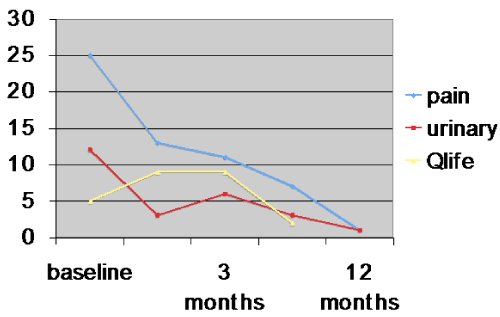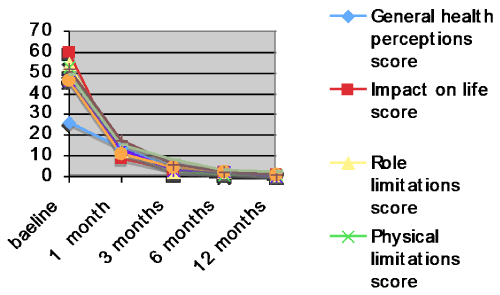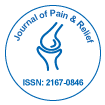Research Article Open Access
Maintenance Of The Response To Sacral Pulsed Radiofrequency In Chronic Prostatitis/Pelvic Pain Syndrome Using Hyperbaric Oxygen
| Gallego-Vilar D*, Cuñat Albert E and Gallego-Gomez J | |
| Departament of Urology, Hospital General Universitario de Castellon, Castellon de la Plana, Valencia, Spain | |
| Corresponding Author : | Daniel Gallego-Vilar Department of Urology Hospital General Universitario de Castellon Castellon de la Plana, Valencia, Spain Tel: 0034649103362 E-mail: dagalvi@hotmail.com |
| Received November 19, 2013; Accepted January 15, 2014; Published January 17, 2014 | |
| Citation: Gallego-Vilar D, Cuñat Albert E, Gallego-Gomez J (2014) Maintenance of the Response to Sacral Pulsed Radiofrequency in Chronic Prostatitis/Pelvic Pain Syndrome using Hyperbaric Oxygen. J Pain Relief 3:131. doi: 10.4172/2167-0846.1000131 | |
| Copyright: © 2014 Gallego-Vilar D, et al. This is an open-access article distributed under the terms of the Creative Commons Attribution License, which permits unrestricted use, distribution, and reproduction in any medium, provided the original author and source are credited. | |
Visit for more related articles at Journal of Pain & Relief
Abstract
Introduction: None of treatments reported for chronic prostatitis/chronic pelvic pain syndrome (CP/CPPS) has shown considerable improvement in patient´s daily life. Our objective is to determine the efficacy of hyperbaric oxygen therapy (HBOT) in the maintenance of response after sacral pulsed radiofrequency (PRF) in patients with CP/CPPS.
Material and methods: Prospective, comparative study including men with CP/CPPS divided in group A: S2-S4 PRF; and group B: S2-S4 PRF+HBO. The evaluated variables were pain (through the visual analog scale, VAS), and quality of life using the The NIH Chronic Prostatitis Symptom Index (CPSI) at 0, 1, 3, 6 and 12 months-follow up. Responders were predefined as patients who had experienced a more than 50% of decrease in the total NIH- CPSI score and more than 50% improvement in different areas of KHQ.
Results: 24 patients met the inclusion/exclusion criteria (17 Group A; 7 Group B) . A significant manteinance of improvement (p<0.05) for pain subscore, urinary subscore, quality of life subscore, total NIH-CPSI score and all the areas of KHQ was noticed in Group B after 18 months follow-up. No adverse effects were reported.
Conclusions: In this study, HBO improved the maintenance of the beneficial effects of sacral PRF among men with CP/CPPS.
| Keywords |
| Pelvic pain syndrome; Hyperbaric oxygen; Pulsed radiofrequency |
| Introduction |
| CP/CPPS is principally defined as pain in a man’s pelvic region that persists for at least 3 months. Estimated general prevalence and overall lifetime prevalence of CP/CPPS is 2-16% [1]. The causes of CP/ CPPS are unknown and its diagnostic is made after “exclusion” of other pathologies [2]. |
| Pain of patients with CP/CPPS usually is the main symptom and it refers to perineal, urethral, scrotal and inguinal zones. Symptoms should have been present for at least 3 months within the previous 6 months [3], and must be validated with the standard questionnaire of the National Institute of Health—Chronic Prostatitis Symptom Index (NIH-CPSI) [4]. In most patients, pain is the main symptom. |
| The lack of a diagnostic and therapeutic “handle” on CP/CPPS dues to urologic community to employ empirical treatments (antibiotics, antiinflammatory agents, 5-α-reductase inhibitors, pentosan polysulfate, phytotherapies, muscle relaxants, antidepressants, and analgesics). With none results in significant cure rates, although most of them result in modest symptom amelioration compared with placebo [5]. |
| Recent data suggest that chronic increment of reactive oxygen species (ROS) may be involved in the development and progression of Chronic prostatic Disease [6] Pulsed radiofrequency (PRF) has been successfully used in treating chronic pain conditions such as low back pain, sacroileitis, neck pain, trigeminal neuralgia and shoulder pain [7] Hyperbaric oxygen therapy (HBO) has been employed satisfactorily in the treatment of other chronic pelvic pains syndroms [8]. |
| The objective of this study is to evaluate the maintenance of the beneficial effects of PRF after HBO among men with CP (CPPS). |
| Materials and Methods |
| Prospective comparative study including men with clinical diagnosis of CP/CPPS (category III) according to the National Institutes of Health (NIH) consensus criteria, and unsatisfied with clinical response to standard conventional therapy (antibiotics, alphablockers, anti-inflammatory agents, phytotherapy) located in our health attending area. |
| Exclusion criteria were: urogenital cancer, documented urinary tract infection (urine culture with >103 colony-forming units/mL of uropathogen in a mid-stream sample of urine), symptomatic genital herpes in the previous 3 months, urological anatomical abnormalities, neurogenic bladder, kidney stones, indwelling catheter, or urinary diversion. |
| We randomly divided patients into two groups (pseudorandomization with EPIDAT 3.0 informatic system), Group A: PRF; Group B: PRF+HBO. |
| PRF was performed under local anesthesia with the patient placed in the prone position. A 22G 100,5mm gauge long spinal needle (active tip: 5mm) was inserted at bilateral S2-S4, and the needle was advanced under quick-check CT fluoroscopy (Figure 1). At each level, correct place was verified by sensory stimulation. The sensor stimulation was required to be less than 0.5 V and at least 1V. PRF was performed at 55°C for 4 minutes in two sessions separated not more than 4 weeks. Group B received no RF energy during procedure. |
| In Group B 30 sessions of HBO (2.5 atmospheres of environmental pressure, ATAs, 60 minutes, breathing 100% oxygen) at a rate of 5 sessions per week was given after PRF. |
| The NIH-CPSI 10 was completed by each patient at baseline, 1, 3, 6 and 12 months after the baseline assessment. We evaluated the general health perception, role limitations, physical limitations, social limitations, personal relationships, emotions and sleep/energy using King´s Health Questionnaire at 1, 3, 6, 12 and 18 months after the baseline assessment. Early withdrawal from the study was classified as treatment failure. Responders were predefined as patients who had experienced more than 50% decrease in the total NIH- CPSI score and more than 50% improvement in different areas of KHQ compared with the baseline (Figure 2). |
| To evaluate differences between CPSI, pain subscore, urinary subscore, and quality of life subscore and mean different areas values of KHQ at 1, 3, 6 and 12 months follow-up and medication usage at baseline, 6 and 18 months by the two groups, we quantitatively analyzed the clinical results. Wilcoxon test was used to test for statistical differences between the two groups. Multivariate analysis was performed using logistic regression to test for correlations among evaluated variables and the use of PRF. ANOVA test was used to evaluate homogeneity of the two groups. SPSS V.17.0 program was used for all statistical analyses; data are presented as mean ± standard deviation. |
| Results |
| 24 patients met the inclusion/exclusion criteria (17 Group A; 7 Group B). The demographic characteristics and previous treatments of the patients are presented in Table 1 and the mean average follow-up period was 19.6 months (SD: 3.4). ANOVA analysis confirmed that the two groups comprised homogeneous patient populations. |
| Symptomatic and quality of life improvements are presented in Tables 2 and 3. In group A significant improvements were apparent at 12 months for total and pain, urinary and quality of life (CPSINIH subscores) of 86.04%, 77.47%, 59.25%, 80.48%, respectively; and significant improvements in all sections of the KHQ (p < 0.05). Symptomatic and quality of life improvements are presented in Tables 2 and 3. In group B significant improvements were apparent at 12 months for total and pain, urinary and quality of life (CPSI-NIH subscores) of 83.5%, 79.12%, 63.16%, 85, 31%, respectively; and significant improvements in all sections of the KHQ (p<0.05). A higher mean of PRF response maintenance was evident in the group B (mean=16.3 months, SD=4.1) compared to the Group A (mean=12.4 months, SD=3.4), and this difference was statistically significant (p=0.021, 95% CI) (graphic I). There was a decrease in the use of medication in group A and B but was not statistically significant (graphic II). |
| Multivariate analysis revealed that severer pain was reported in patients with a higher time to start the study (p: 0.024; CI, 95%) and significant differences between General State of health, Daily role limitations and personal feelings in KHQ (p: 0.019; 0.031; 0.017 respectively). No differences were found depending previous treatments, age or comorbidity (Table 1). |
| Discussion |
| The purpose of the present study is to investigate the therapeutic efficacy of percutaneous PRF vs. PRF+HBO in the symptomatic management of refractory chronic pain in CP/CPPS. |
| The precise etiology of CP/CPPS is unknown but many studies have revealed that the pain of CP/CPPS may be neuropathic. Yang et al. demonstrated the presence of central sensitization in patients with CP/CPPS [8], comparing thermal algometry in men with CP/ CPPS with asymptomatic controls, reporting higher scores in visual analogical scale to short bursts of noxious heat stimuli to the perineum but no difference to the anterior thigh showing altered sensation in the perineum of patients with CP/CPPS compared with controls. |
| PRF alters synaptic transmission, in a neuromodulatory-type effect. It has been found ultrastructural axonal changes in animal studies [9,10]. These histological findings are believed to be a result of the high transmembrane potentials generated with tissues exposed to the electrical fields during PRF application [11]. In order to this findings severtal therapeutical options have emerged for controlling CP/CPPS. |
| Electroacupuncture (EA) has anti-inflammatory and neuromodulatory mechanisms [12] and in a 3-arm randomized clinical trial, it has shown significantly beneficial after 6 weeks compared with both sham EA and advice and exercise alone [13]. In another study a high frequency, urethral-anal prototype stimulation device twice weekly was tested in men with CP/CPPS [14] with a significant decrease in the NIH-CPSI (P=0.0002) with no urethral, anal complaints or other side effects. In our study, all patients under S2-S4 PRF experienced a significant decrease in total NIH-CPSI and KHQ. |
| HBO has been used for other pelvic pain disorders as pelvic pain syndrome. In one study, 11 cases showed significant improvements in pain, urgency, and frequency of voids and OSICSI/PI scores [15]. At five sessions per week, these patients had received 2 to 4 weeks of HBO treatment at a rate of 2.0 ATAs, and the response to treatment was maintained for up to 2 years. This study was a continuation of two cases with similar results that had already been published by the same author [16]. Van Ophoven et al. presented six cases in which HBO was applied under conditions similar to our study (30 sessions per patient, 2.5 ATAs). With a mean follow-up of 12 months, the authors showed improvements in the frequency to void and in pain [17]. |
| In our study patients in group B have significant improvements at 12 months for total and pain, urinary and quality of life (CPSI-NIH subscores) and in all sections of the KHQ (p<0.05) with a higher mean of PRF response maintenance vs. patients in Group A (mean=16.3 months, SD=4.1 and 12.4 months, SD=3.4 respectively), and this difference was statistically significant (p=0.031, 95% CI). In Van Ophoven’s study, the maintenance of the beneficial effect of HBO last for a mean of 11.3 months for PBS. |
| Conclusion |
| PRF and HBO may lead a new chance men with CP/CPPS, more studies are needed to assess the real benefit of these two novel treatments for this pathology. |
References
- Abrams PH, Cardozo L, Fall M, Griffiths D, Rosier P, et al. (2002) The standarization of terminology of lower urinary tract function: report from the standarization sub-committee of the international continence society. Neurourol Urodyn 21: 167-178.
- Le BV, Schaeffer AJ (2009) Genitourinary pain syndromes, prostatitis, and lower urinary tract symptoms. Urol Clin North Am 36: 527-536.
- Pontari MA (2008) Chronic prostatitis/chronic pelvic pain syndrome. Urol Clin North Am 35: 81-89.
- Schaeffer AJ, Datta NS, Fowler JE Jr, Krieger JN, et al. (2002) Overview summary statement. Diagnosis and management of chronic prostatitis/chronic pelvic pain syndrome (CP/CPPS). Urology 60:1-4.
- Anothaisintawee T, Attia J, Nickel JC, Thammakraisorn S, Numthavaj P, et al. (2011) Management of chronic prostatitis/chronic pelvic pain syndrome: a systematic review and network meta-analysis. JAMA 305: 78-86.
- Scavuzzo A, Favilla V, Cimino S, Madonia M, Li Volti G, et al. (2012) The Relationship between oxidative stress and obesity in prostate disease. Urologia 79: 156-158.
- Chua NH, Vissers KC, Sluijter ME (2011) Pulsed radiofrequency treatment in interventional pain management: mechanisms and potential indications-a review. Acta Neurochir (Wien) 153:763-771.
- Gallego Villar D, García Fadrique G, Povo Martín IJ, Miralles Aguado J, Garau Perelló C, et al. (2011) Hypebaric oxygen treatment in urology. Arch Esp Urol 64: 507-516.
- Yang CC, Lee JC, Kromm BG, Ciol MA, Berger RE (2003) Pain sensitization in male chronic pelvic pain syndrome: why are symptoms so difficult to treat? Urol 170: 823-826.
- Erdine S, Yucel A, Cimen A, Aydin S, Sav A, et al. (2005) Effects of pulsed versus conventional radiofrequency current on rabbit dorsal root ganglion morphology. Eur J Pain 9: 251-256.
- Podhajsky RJ, Sekiguchi Y, Kikuchi S, Myers RR (2005) The histologic effects of pulsed and continuous radiofrequency lesions at 42 degrees C to rat dorsal root ganglion and sciatic nerve. Spine 30: 1008-1013.
- Snidvongs S, Mehta V (2010) Pulsed radio frequency: a nonneurodestructive therapy in pain management. Curr Opin in Support Palliat Care 4: 107-110.
- Chen R, Nickel JC (2003) Acupuncture ameliorates symptoms in men with chronic prostatitis/chronic pelvic pain syndrome. Urology 61: 1156-1159.
- Lee SH, Lee BC (2009) Electroacupuncture Relieves Pain in Men with Chronic Prostatitis/Chronic Pelvic Pain Syndrome: Three-arm Randomized Trial. Urol 73: 1036-1041.
- John H, Rüedi C, Kötting S, Schmid DM, Fatzer M, et al. (2003) A new high frequency electrostimulation device to treat chronic prostatitis. J Urol 170: 1275-1277.
- Tanaka T, Kawashima H, Makino T, Kamikawa S, Kato N, et al. (2007) Hyperbaric oxygen therapy for interstitial cystitis resistant to conventional treatments. Int J Urol 14: 563-565.
- Van Ophoven A, Rossbach G, Pajonk F, Hertle L (2006) Safety and efficacy of hyperbaric oxygen therapy for the treatment of interstitial cystitis: a randomized, sham controlled, double-blind trial. J Urol 176: 1442-1446.
Tables and Figures at a glance
| Table 1 | Table 2 | Table 3 |
Figures at a glance
 |
 |
| Figure 1 | Figure 2 |
Relevant Topics
- Acupuncture
- Acute Pain
- Analgesics
- Anesthesia
- Arthroscopy
- Chronic Back Pain
- Chronic Pain
- Hypnosis
- Low Back Pain
- Meditation
- Musculoskeletal pain
- Natural Pain Relievers
- Nociceptive Pain
- Opioid
- Orthopedics
- Pain and Mental Health
- Pain killer drugs
- Pain Mechanisms and Pathophysiology
- Pain Medication
- Pain Medicine
- Pain Relief and Traditional Medicine
- Pain Sensation
- Pain Tolerance
- Post-Operative Pain
- Reaction to Pain
Recommended Journals
Article Tools
Article Usage
- Total views: 13754
- [From(publication date):
February-2014 - Apr 02, 2025] - Breakdown by view type
- HTML page views : 9258
- PDF downloads : 4496
